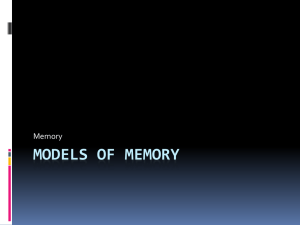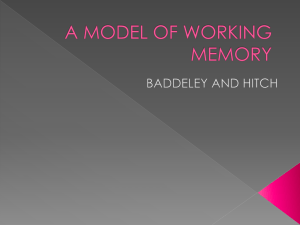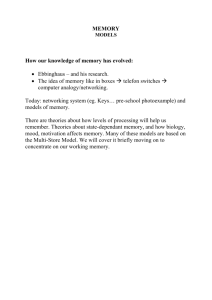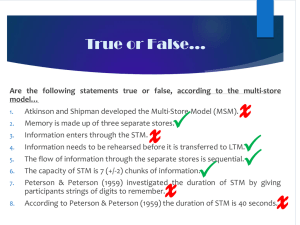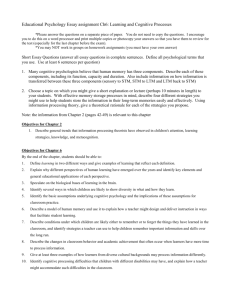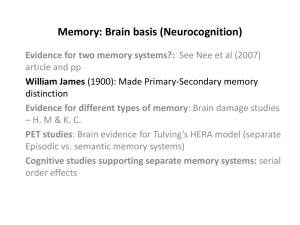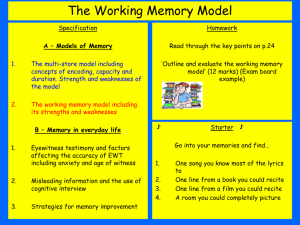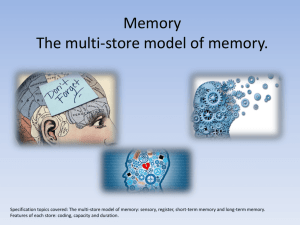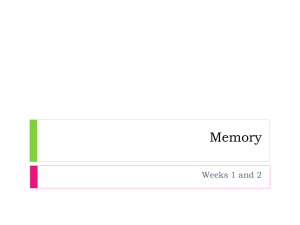Evaluating MSM and WM - The Grange School Blogs
advertisement
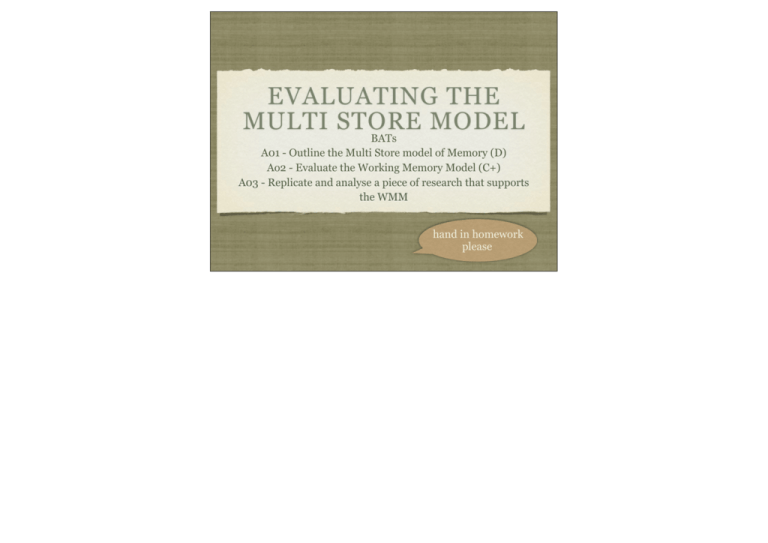
EVALUATING THE MULTI STORE MODEL BATs A01 - Outline the Multi Store model of Memory (D) Ao2 - Evaluate the Working Memory Model (C+) A03 - Replicate and analyse a piece of research that supports the WMM hand in homework please NOW TRY SOME REAL EXAM QUESTIONS!! 1.a. The diagram below illustrates the multi-store model of memory. Write down the appropriate labels for A and B (2 marks) Sensory memory A B Long-term memory 1.b.Explain one strength of the multi-store model of memory (2 marks) EVALUATING THE MSM On the worksheet provided jot down at least 3 positive criticisms of the MSM (use last week’s notes) Evidence for Multi-store model: 1. Primacy-Recency Effect - Atkinson (1970). When presented with lists to remember we recall first and last items best. First items rehearsed into LTM and last items recalled from STM. Ones in middle less likely to be recalled. This is evidence for existence of several stores. 2. Brown –Peterson Technique suggests that if rehearsal of items is prevented then information does not enter LTM. 3. Amnesiacs caused by Korsakoffs Syndrome brought on by chronic alcoholism display sound STM functioning but impaired LTM. This suggests separate and distinct memory stores. Evidence for Multi-store model: 4. Scolville & Milner (1957) , Wicklegren (68) – The case of HM Loss of LTM after surgery for epilepsy. Severe problems with making new long term memories. STM mostly unaffected. 5. Brain imaging - STM and LTM can be linked to specific areas of the brain. • Beardsley (1997) - Prefontal cortex active when working on a task in STM. • Squire et al. (1992) – Hippocampus is active when LTM is engaged. 6. Case of Clive Wearing - but does this case provide evidence for or against the model? EVALUATING THE MSM We will now need to look at Criticisms In pairs can you think of any problems with this model NEGATIVE CRITICISMS OF THE MSM MODEL Make an effort to remember these today as you may be asked to write an essay on it later 1.Clinical case studies – Shallice and Warrington (1970) – The case of KF – suggestion that there is more than one type of STM. 2.MSM is over simplified – assumes a single STM and LTM. Diff types of LTM (Procedural, episodic and semantic). Clive Wearing able to play piano SUGGESTED 4 LONG TERM STORES • Semantic memory – memory for knowledge about the world, including knowledge about words • Episodic memory – memory for what you did yesterday or a film you saw last week • Procedural memory – memory for riding a bike or learning to read or play an instrument • Perceptual-representation system (PRS)memory related to perceptual priming (enhanced recognition of stimuli which have been seen before e.g. if given the word TOBOGGAN and then later able to recognise the word from –O-O-GA- - .) Evidence against Multi-store Model: More Negative Criticisms of the MSM 3. The ‘one-way’, linear direction of the MSM appears to be incorrect: There is a two-way flow of info between STM and LTM, Morris et al (1985). Logie (1999) – STM relies on LTM so cannot come before it as suggested in the MSM. Evidence for this is when chunking letters to make acronyms. You need to recall the meaningful groups of letters. The meanings are stored in LTM 4. Doesn’t help explain why we can remember things we have not rehearsed. Rehearsal is not always needed to enable memories to be transferred from STM to LTM e.g. smells cannot be rehearsed, Flashbulb memories Multi-store model is basic and limited in explaining such a complex phenomenon as memory. ESSAY TYPE QUESTIONS Strategies to use Read the notes showing 2 ways of attacking an essay type question Use one of these strategies to write an essay for the following question: Outline and evaluate Atkinson and Shiffrin’s Multi-store model of memory. (12 marks) MINI MOCK You have 30 minutes to answer the questions on the sheet There is more or less a minute for each mark Try your best Working Memory - Baddeley & Hitch (1974) • An alternative to the Multi-store Model. • Emphasises workings of STM. • It is a far more complex explanation of STM. • Baddeley and Hitch (1974) provide evidence for this by people being able to carry out more than one task at once where both tasks involve STM functions. Working Memory - Baddeley & Hitch (1974) The term ‘working memory’ refers to that bit of memory you use when working on a complex task which requires you to store info as you go along. e.g. adding 15+ 14+ 35… you add the 15 and 14 and hold it in WM before adding the 35. e.g when reading a sentence you store each word in WM while you work out the meaning of the sentence 13975284 BA A follows B True/false. AB B is not preceded by A True/false. Now write down the sequence of numbers you were originally asked to recall. 13975284 WORKING MEMORY BADDELEY & HITCH (1974) • According to Miller and his 7 +/- 2 theory and Atkinson and Shiffrin the STM reached full capacity so not all the info should be able to be recalled and processed. • Therefore the STM is more complex and may have several subsystems that can operate simultaneously. • They studied the possibility of two subsystems in particular which were governed by a central controlling mechanism which they termed the Central Executive . Working Memory - Baddeley & Hitch (1974) STM not just one store, but a number of different stores or SUBSYSTEMS each having a specialised function. Why did they think this? When doing 2 tasks at the same time that are similar e.g. both visual, performance is worse than when doing them separately E.g Visualising a football game on the radio when driving caused Baddeley to veer off the road When doing 2 different tasks e.g. visual and acoustic, there is no interference and both are done equally well. PHONOLOGICAL STORE VISUO-SPATIAL SKETCH PAD CENTRAL EXECUTIVE REHEARSAL REHEARSAL Working Memory - Baddeley & Hitch (1974) Over to you you will need to report what you find out to the other groups You will be given a number from 1-3 Everyone in group 1 will find out the role of the Central Executive Group 2 will find out about the Phonological loop Group 3 will find out about the Visuo-Spatial Sketchpad The Central Executive • This ‘fat controller’ is the boss and supervises and coordinates the other subsidiary systems. • The central executive decides which information is attended to and which parts of the working memory to send that information to be dealt with. • Has a very limited capacity The two subsystems studied were named: • the Visuo-spatial Sketchpad • the Phonological/Articulatory Loop. The Visuo-Spatial Sketchpad • Deals with what information looks like (visual) and how it is laid out (spatial) E.g getting from one room to another or counting the number of windows in your house • Top sportsmen rely on efficient visual-spatial processing – they need to be able to visualise the spatial relationship between objects when the objects are in motion. The Phonological Loop • Holds spoken information for about 1.5 to 2 seconds. • Preserves the order of information • Written words must be converted to spoken words to enter phonological loop. • In ’86 Baddeley divided the phonological loop into: • Phonological Store – holds words you hear (inner ear) • Articulatory Process – used for words heard or seen, silently repeated (sub-vocal) – (inner voice)


